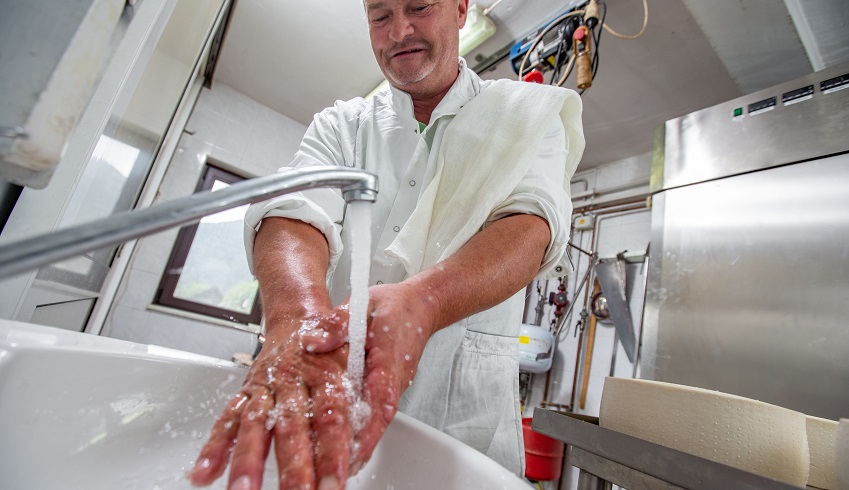Articles
January 09, 2025
4 tips to help prevent the spread of Norovirus
Use proper food safety practices to prevent the illness becoming foodborne.

Always wash hands carefully with soap and water, especially after using the bathroom, and before eating, preparing, or handling food.
Norovirus cases are spiking this winter – reaching the highest levels in more than a decade.
Norovirus is a very contagious virus that causes gastroenteritis. According to the U.S. Centers for Disease Control and Prevention (CDC), 58% of foodborne illnesses are caused by Norovirus transmitted when someone sick touches or prepares food items, or sometimes if the food comes in contact with contaminated water.
“Norovirus is always a problem, but it’s particularly challenging during the winter,” says Patrick Guzzle, the National Restaurant Association’s vice president of Food Science and Industry. “The colder days frequently find us gathered in indoor areas more frequently, and because noroviruses are highly contagious, they can spread rapidly in a community. As good hosts to our guests, it’s important we always practice good hygiene and avoid working with foods when we, ourselves, are sick,” Guzzle says, “and this is even more important in the winter when Norovirus—and other illnesses—can quickly spread.”
Food often becomes contaminated with Norovirus when infected people touch it, if it’s placed on counters or surfaces contaminated with the virus, or if the food is grown or harvested in contaminated areas. If a restaurant or foodservice employee infected with Norovirus touches any food or beverages, he or she could easily contaminate them, and the people who consume the products.
Learn more about food-safety training and best practices to prevent foodborne illness in the restaurant industry at ServSafe and Food Safety Focus.
Norovirus is a very contagious virus that causes gastroenteritis. According to the U.S. Centers for Disease Control and Prevention (CDC), 58% of foodborne illnesses are caused by Norovirus transmitted when someone sick touches or prepares food items, or sometimes if the food comes in contact with contaminated water.
Occurrences are most common in winter
There are about 2,500 reported Norovirus outbreaks in the U.S. every year, and it’s most common to occur from November through April when people tend to gather indoors more frequently. Sometimes called the stomach flu, Norovirus causes an inflammation of the stomach or intestines, and is highly contagious. Additionally, the virus particles can become airborne easily. When infected with Norovirus, individuals can feel extremely ill, exhibiting symptoms that include vomiting and diarrhea, which can lead to dehydration. Most get better within 1 to 3 days, but they can still spread the virus for a few days afterward.“Norovirus is always a problem, but it’s particularly challenging during the winter,” says Patrick Guzzle, the National Restaurant Association’s vice president of Food Science and Industry. “The colder days frequently find us gathered in indoor areas more frequently, and because noroviruses are highly contagious, they can spread rapidly in a community. As good hosts to our guests, it’s important we always practice good hygiene and avoid working with foods when we, ourselves, are sick,” Guzzle says, “and this is even more important in the winter when Norovirus—and other illnesses—can quickly spread.”
Food often becomes contaminated with Norovirus when infected people touch it, if it’s placed on counters or surfaces contaminated with the virus, or if the food is grown or harvested in contaminated areas. If a restaurant or foodservice employee infected with Norovirus touches any food or beverages, he or she could easily contaminate them, and the people who consume the products.
An ounce of prevention is worth a pound of cure
Use these four tips to help prevent Norovirus from spreading.- Don’t prepare, serve, or touch food for others when sick. Food workers should stay home for at least 48 hours after symptoms stop. Employees who are infected with the virus should inform managers if they have any symptoms of Norovirus illness or were recently sick. When returning to work, they should continue to take precautions, such as frequent handwashing.
- Practice proper hand hygiene. Always wash hands carefully with soap and water, especially after using the bathroom and before eating, preparing, or handling food. You can use alcohol-based hand sanitizers, BUT only in addition to hand washing. Sanitizers should not be used as a substitute for washing with soap and water. Furthermore, avoid touching food with bare hands, especially those foods that are ready-to-eat. Use gloves or tongs instead. Also, always wash hands before and after using gloves to prevent cross-contamination.
- Wash fruits and vegetables and cook seafood well. Carefully wash fruits and vegetables before preparing and/or eating them. Cook shellfish thoroughly. Thorough cooking is important because Noroviruses can survive temperatures as high as 145°F. In fact, quick steaming processes often used for cooking shellfish won’t kill the virus. Make sure to discard any food that may have been contaminated with Norovirus.
- Clean and disinfect contaminated surfaces. After throwing up or having diarrhea, immediately clean and disinfect contaminated surfaces, such as tables or countertops. Use a chlorine bleach solution with a concentration of 1,000 to 5,000 ppm (the equivalent to 5 to 25 tablespoons of household bleach per gallon of water), or another disinfectant registered as effective against Norovirus by the Environmental Protection Agency (EPA).
Learn more about food-safety training and best practices to prevent foodborne illness in the restaurant industry at ServSafe and Food Safety Focus.
Sign up for our Newsletter
The latest news from the National Restaurant Association, published every other Thursday
By clicking Submit I agree to receive email communications from the National Restaurant Association and agree to our Privacy Policy(Opens in a new window).